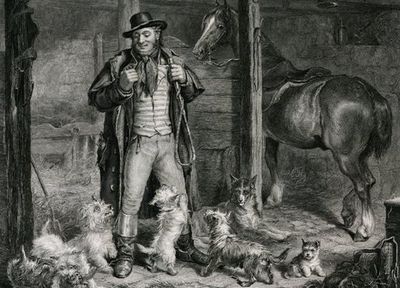Annotation:Dandie Dinmont
X:1 T:Dandie Dinmont C:Joseph Lowe M:C L:1/16 R:Strathspey B: Joseph Lowe - Lowe's Collection of Reels, Strathspeys and Jigs, B:book 4 (1844–1845, p. 17) Z:AK/Fiddler’s Companion K:Emin d2|B<E3{c}B3A BE3Ee3|d3BAd3 FD3 BAGF|BE3{c}B3A BE3Ee3|d3B{B}A3F EEE2 E2:| f2|{a}g3feb3 ge3b3e|d3ef3g agfe df3|{a}g3feb3 ge3b3e|dB3{B}A3F EEE2 E2f2| {a}g3feb3 ge3b3e|d3ef3g agfed df3|(3g2a2b2 (3e2f2g2 (3f2g2a2 (3d2e2f2|d3B{B}AF3 EEE2 E2||

The only dog breed known to have its name taken from a character in literature is the Dandie Dinmont terrier. First breed in Scotland, the terrier breed may be closely related to the Bedlington terrier, although the dog's ancestry probably includes strains of basset hound, border terrier and Cairn terrier. The Dandie Dinmont was originally developed for hunting small game and particularly became known for the ability to track otter. Over the years, the Dandie became more of a house pet and show dog, valued for a distinct appearance.
Lowe sometimes named his compositions from characters in the works of Burns and Scott.

